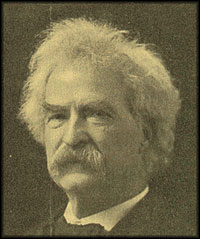 |
||
  |
||
|
|
American Literary Humor: Mark Twain, George Harris, and Nathaniel Hawthorne—Curriculum Unit Overview—IntroductionIn this three-part curriculum unit, students examine structure and characterization in several short stories and consider the significance of humor through a study of several American writers. One or all lessons can be taught individually or linked together as a unit on 19th century American humor. In Lesson One: Mark Twain and American Humor, through skits and storytelling, students first examine the structure of Twain's story "The Celebrated Jumping Frog of Calaveras County" and the role he creates for his tall-tale storyteller, Simon Wheeler. They then investigate Twain's use of dialect by continuing a story that Wheeler starts to tell, imitating his comic style. In Lesson Two: Southwest Humorists and George Washington Harris, students compare Twain's story with one of the Sut Lovingood stories by Harris, again examining the story's structure by performing it as a skit. After considering how this structure "frames" the trickster Sut Lovingood, as compared to the frame Twain creates for his trickster, Jim Smiley, students produce a character sketch of Harris' comic protagonist and a sample of his humorous dialect. Finally, in Lesson Three: Nathaniel Hawthorne and Literary Humor, students read a humorous story by Nathaniel Hawthorne in order to gain perspective on various brands of humor and their significance within the context of American literary tradition. After debating the merits of "moral" humor like Hawthorne's as compared with the "folk" humor of Harris and Twain, students test the possibilities of blending these traditions by recasting a paragraph of Hawthorne's story in dialect style.Guiding Questions
Learning ObjectivesAt the end of this lesson, students we be able to:
Background Information for the TeacherMark Steadman, in his "Humor in Literature" entry from the Encyclopedia of Southern Culture (published 1989) available at the EDSITEment-reviewed Documents of the American South, describes four general periods of humor in American Southern literature, the first two of which are relevant to the unit: 1830 to 1860 and 1860 to 1925 (the remaining two comprise the range of dates remaining before and after the second World War). These two early periods are detailed in the first four paragraphs of the article, with specific mention of Mark Twain (1835-1910) and his predecessor George Washington Harris (1814-1869), and prove useful as a general introduction to the subject. The influence of writers like Harris and his peers is evident in Mark Twain's "Jumping Frog," most notably in the structure and narration of the story. As Steadman argues, "Generally these writers carefully separated themselves from the disreputable characters of their sketches by using an "envelope" structure, in which a literate narrator introduced the illiterate character who told the story." This, of course, describes the frame structure of "Jumping Frog" exactly, exhibiting Mark Twain's careful use of his predecessors' strategies.The final lesson in this unit presents Nathaniel Hawthorne's New England sensibility as a contrast to the southern vernacular presented in the two other stories. Published in 1837 in Hawthorne's Twice-Told Tales, "Dr. Heidegger's Experiment" presents a sharper satire, with a more refined narrative style. Students discuss the narrative style of the story and compare the story's themes and humor to that of the others presented in this curriculum unit. For information about the authors covered in this lesson, the biographies of Harris and Twain are both available at Documents of the American South. A biography of Nathaniel Hawthorne is available at the EDSITEment-reviewed Hawthorne in Salem.
Preparing to Teach this Curriculum Unit
Unit LessonsLesson 1. Mark Twain and American HumorLesson 2. "Old Southwest" Humorists and George Washington HarrisLesson 3. Nathanial Hawthorne and Literary HumorSelected EDSITEment Websites
Standards Alignment View your state’s standards |
||||||||||||||||||||||||||||||||||||||||||||||||||||||||||||||||
  |
||
| EDSITEment contains a variety of links to other websites and references to resources available through government, nonprofit, and commercial entities. These links and references are provided solely for informational purposes and the convenience of the user. Their inclusion does not constitute an endorsement. For more information, please click the Disclaimer icon. | ||
| Disclaimer | Conditions of Use | Privacy Policy Search
| Site
Map | Contact
Us | ||
